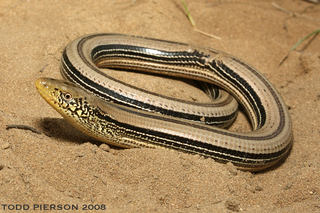Post by Ceratodromeus on Jan 15, 2016 1:16:39 GMT 5

Scientific classification
Kingdom: Animalia
Phylum: Chordata
Subphylum: Vertebrata
Class: Reptilia
Order: Squamata
Family: Anguidae
Genus: Ophisaurus
Species
Ophisaurus attenuatus – slender glass lizard
Ophisaurus buettikoferi – Borneo glass lizard
Ophisaurus ceroni – Ceron's glass lizard
Ophisaurus compressus – island glass lizard
Ophisaurus formosensis – Formosan glass lizard
Ophisaurus gracilis – Burmese glass lizard
Ophisaurus hainanensis
Ophisaurus harti – Chinese glass lizard or mud dragon
Ophisaurus incomptus
Ophisaurus koellikeri – Moroccan glass lizard
Ophisaurus mimicus – mimic glass lizard
Ophisaurus sokolovi – pink lizard
Ophisaurus ventralis – eastern glass lizard
Ophisaurus wegneri – Sumatra glass lizard
Description
These animals are limbless lizards that at first glance, resemble snakes. However, a keen eye will readily help distinguish a legless lizard from a snake -- one notable difference being that legless lizards have moveeable eyelids, and external ear openings, which snakes do not. They get their common name as most observers feel as though the animal is incredibly brittle when handeling, as though they may break into 100 pieces of glass. Whilst not true, the tail is easily automotized, and animals very rarely have their original tails as adults. North American members of this genus are fairly uniform overall, possessing very similar patterning -- this patterning consists of a dorsal stripe, with two stripes running parrelel to it on either side of the animal's back. Species can be distinguished by subtle differences(breakages in these stripes), and body coloration as well. Some North American species are brown with black striping, some have an iridescent blue sheen to them, and others are a steel grey with brown striping. North american species are fairly similar in size overall, with animals ranging anywhere from 15-42in(38-106cm) in total length{1}. The tail makes up to 2/3 of the animals' total body length.

Geographic range
The Ophisaurus genus is a really wide-spread, with most of the species being found in the South Eastern United States -- ranging from Texas to Virginia. There is also at least one recognized Species in China, Borneo, Burma, and Thailand{2}. Glass lizards are partial to prairies, woodlands, flatwoods, and grasslands, and are accomplished burrowing animals, and spend most of their day either in these burrows, or under logs, large rocks, or mad made debris.

Dietary habits
Ophisaurus lizards are predominately insect eaters (katydids, grasshoppers, butterflies, though they will eat anything they come across. This includes spiders, snails, ground nesting birds' eggs, lizards(Aspidoscelis sexlineata){3}, and occasionally snakes. It is typically only the larger species of Ophisaurus that will predate the latter two prey categories {2}.
Reproduction
Not much is known about species outside of North America, but a similar ecology, and therefore reproduction habits can be assumed. The Ophisaurus lizards are oviparous, with females guarding their clutch -- which ranges from 10-20 eggs, depending on the size of the maternal femals -- until they hatch. Young animals typically measure 6-8inches in total length {1}.

References
{1} Conant, Roger, and Joseph T. Collins. A field guide to reptiles & amphibians: eastern and central North America. Vol. 12. Houghton Mifflin Harcourt, 1998.
{2} Hamilton, W. J., and Joseph A. Pollack. "The food of some lizards from Fort Benning, Georgia." Herpetologica (1961): 99-106.
{3} Palmer, William M. Reptiles of North Carolina. Univ of North Carolina Press, 1995.



